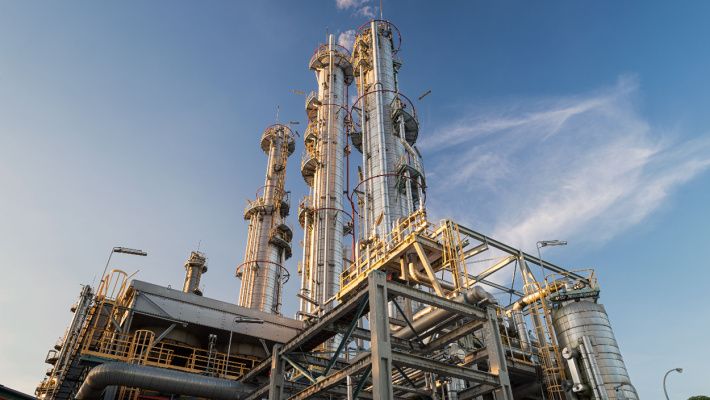Thursday Nov 23 2023 10:37

7 min

Natural gas is found deep underground, alongside coal and other fossil fuel deposits. It is extensively used in the US, accounting for 25% of US energy consumption. The gas primarily consists of methane.
It is priced in USD per British thermal unit (mmBtu). The highest price recorded for Natural gas was $15.30 in December 2005, a record low of $1.02 was seen in January 1992.
From cooking our favourite meals to heating our homes during bone-chilling winters, natural gas plays a pivotal role. You've probably heard its name, but how well do you know it?
Join us as we unearth the story of this incredible energy source: what it is, its history, and how it lights up our world, literally!
Natural gas, a critical component in the global energy matrix, has a storied history that predates modern industrialization. In ancient times, natural gas seepages occasionally ignited, creating spontaneous flames, which was intriguing and perplexing to early civilizations.
Although societies like the ancient Chinese capitalised on these seepages by employing rudimentary means for localised uses, the comprehensive exploitation of natural gas as a primary energy source remained uncharted for many centuries.
The 19th century saw a surge in crude oil exploration and extraction, driven by the demands of a rapidly industrialising world.
During this epoch of exploration, many oil wells inadvertently encountered pockets of natural gas. Initially, this gas was often dismissed as a less valuable byproduct of the more lucrative crude oil, with vast amounts flared off without harnessing its potential.
Nonetheless, with increasing recognition of its distinct attributes, particularly its efficiency and cleaner combustion, natural gas began to gain traction as an energy source of significant import.
By the advent of the 20th century, the global dependence on oil was firmly entrenched, but the role of natural gas was steadily ascending. Technological advancements in drilling, storage, and transportation methodologies rendered the extraction and distribution of natural gas more feasible.
Consequently, natural gas emerged not merely as a supplemental resource alongside crude oil but as an indispensable component of the world's energy strategy, heralding a new era in its historical trajectory.
Natural gas is primarily used for heating, electricity generation, cooking, and as fuel for vehicles. Additionally, it serves as a crucial raw material in a lot of industrial processes, including the production of chemicals, plastics, and fertilisers. Its clean-burning properties make it a preferred choice for many applications, aiming to reduce greenhouse gas emissions compared to other fossil fuels.

Natural gas primarily comprises methane (CH₄), which typically accounts for at least 70-90% of its volume. However, the exact composition can differ depending on the source and location of the extraction. In addition to methane, natural gas can contain tiny amounts of other hydrocarbons such as ethane (C₂H₆), propane (C₃H₈), butane (C₄H₁₀), and pentane (C₅H₁₂).
Trace amounts of other substances might also be present, including carbon dioxide (CO₂), nitrogen (N₂), water vapour, and in some cases, hydrogen sulphide (H₂S), which is a corrosive and toxic gas.
Before distribution, natural gas is often processed to remove many of these impurities, ensuring it meets the specifications required for its intended use.
For natural gas, the calorific value can vary depending on its exact composition, particularly the concentration of methane and other hydrocarbons. On average:
For precise values and applications, especially in engineering or industrial contexts, its crucial to consult region-specific or source-specific data, as the calorific value of natural gas can differ based on its extraction and processing.
No, LPG (Liquefied Petroleum Gas) is not a natural gas; it is a byproduct of natural gas processing and crude oil refining, primarily composed of propane and butane.
No, natural gas and petrol (or gasoline) are distinct fuels with different compositions and uses.
Both natural gas and LPG (Liquefied Petroleum Gas) have safety considerations. Still, in general, natural gas is lighter than air and will dissipate more quickly when released, reducing the risk of ignition.
In contrast, LPG is heavier than air and can accumulate in low areas, potentially posing a greater explosion risk if not ventilated. Proper handling and storage are crucial for both fuels to ensure safety.
The United States Natural Gas Fund® LP (UNG) is an exchange-traded security that is designed to track in percentage terms the movements of natural gas prices. UNG issues shares that may be purchased and sold on the NYSE Arca.
The investment objective of UNG is for the daily changes in percentage terms of its shares' net NAV to reflect the daily changes in percentage terms of the price of natural gas delivered at the Henry Hub, Louisiana, as measured by the daily changes in the Benchmark Futures Contract, less UNG's expenses.
Natural gas, a silent marvel tucked deep within the Earth, has powered civilizations, fueled industries, and shaped the trajectory of our planet's energy paradigm.
From its enigmatic presence in ancient times to its central role in today's energy landscape, its significance is undeniable.
As consumers and stewards of this invaluable resource, we must appreciate its history, understand its properties, and use it responsibly.
Whether you are harnessing it for warmth on a cold evening or driving an industry forward, natural gas stands as a testament to nature's profound ability to sustain and energise life in myriad ways.
Here's to a deeper appreciation and responsible use of this incredible gift from the depths of our planet.
Meanwhile, if you are interested in trading CFDs then you are at the right place.
Join our amazing community today here at markets.com and explore a world of opportunities.
“When considering foreign currency (forex) for trading and price predictions, remember that trading CFDs involves a significant degree of risk and could result in capital loss. Past performance is not indicative of any future results. This information is provided for informative purposes only and should not be construed to be investment advice.”